Step dances. Various types of step-dances were performed to jigs, hornpipes and reels. These were typically danced solo, or by a pair or small group of dancers. Most of the movement occurred from the waist down, with emphasis being placed on intricate movements of the feet. Touching between partners was kept to a minimum. In a late nineteenth century or early twentieth century Irish house dance, a solo or two-hand step dance or perhaps a four hand reel would typically be performed as an exhibition while the main body of dancers took a break from quadrilles, barn dances and waltzes. In the following recording, Martin Howley (1902-1981) of Fanore, County Clare plays an untitled jig on his German concertina. The recording is courtesy of Jim Carroll.
Each of the three principal step-dance rhythms of Ireland were in all likelihood European imports, just as were the quadrilles, waltzes and polkas that were later so reviled as "foreign" by the Gaelic League and the clergy (see Chapter 6). The jig was in England by the sixteenth century, and arrived in Ireland in the seventeenth, according to Breandan Breathnach.![]() 13 The hornpipe and the reel arrived in Ireland much later, by the end of the eighteenth century.
13 The hornpipe and the reel arrived in Ireland much later, by the end of the eighteenth century.![]() 14
14
All of these arriving step dances had been integrated into Irish dance custom by the time of arrival of quadrilles in the early nineteenth century. As quadrilles then became more and more popular, their popularity came at the expense of these earlier step dances. However, arriving quadrille tunes were written in 6/8 and 2/4 time, which allowed local Irish step-dance tunes -jigs, hornpipes, and reels - to be substituted into the sets of quadrilles ("sets" in modern Irish usage). As Breathnach has observed of quadrilles, "Their sustained and widespread popularity was, without doubt, responsible for keeping alive a great deal of native dance music."![]() 15
15
In England, step dances have long been performed by men in pubs, as Sussex resident Scan Tester recounted:
There used to be what we called a reel. It was ordinary four corners, four of them, and they used to step, and then the second part they change over and go in and form the figure-eight. And really, it was old people that done it, mind you. The young ones, they used to join in. Get two in a set, see, and learn 'em.![]() 16
16
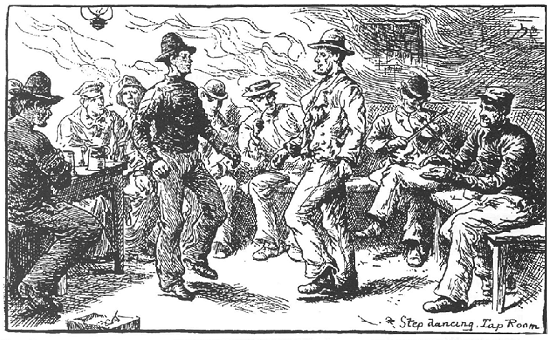
Dancing in the tap room of a Norfolk pub. From The Graphic, October 22, 1887,
and from Reg Hall's I Never Played To Many Posh Dances (1990).
In colonial Australia - which was substantially populated by immigrants from England, Ireland, Wales and Scotland - jigs and reels were danced by these immigrants and their children. These dances, however, did not have particular staying power beyond the first or second generation. By the end of the nineteenth century it was not common, but still not unheard of, to see step dances occurring within typical Australian rural dances. Tunes in single jig, single reel (rarely the double form of either) tempo, however, are prominently played in Australia figures of sets within quadrilles, just as they are in Ireland. The Irish also use hornpipes for some quadrille/set figures, which is uncommon in Australia. In the following recording, George Bennett (1878-1966) of Gunnedah, NSW plays a step-dance jig, George Redder's Step, that was recorded in the early 1960s. The recording is courtesy of Rob Willis and the National Library of Australia.
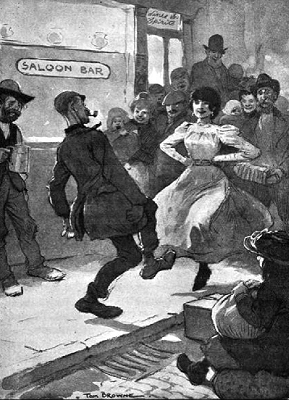
Step dancing outside of a pub, Kent England; note the concertina player in the background.
Scan Tester often played for step-dancing at these pubs during hop-picking season.
The illustration is from Robert Machray, The Night Side of London, 1902.
Country Dance. Large group social dancing in Ireland and England in the early nineteenth century consisted primarily of the country dance, where relatively large groups of dancers formed long lines or circles and performed various geometric maneuvers. This form originated in rural England in the sixteenth century, and migrated to both Ireland and France. In France it became the contredanse, and was re-exported to northeastern America to become the contra dance. A variant in Ireland was called the rinnce fada (long dance), which was danced for King James at his arrival in Kinsale in 1689. Country dance was popular throughout the eighteenth century, and into the early nineteenth. Dancing masters taught both forms to eager pupils of all classes in rural Ireland.
Country dances typically employ rhythms in 2/4 and 4/4 time (single reels and marches) as well as jig time (6/8), although more exotic rhythms are also found (e.g., 3/2, 6/4, and 9/8). Typical and still-danced examples are the longways dances Sir Roger de Coverley (England) or the Virginia Reel (America), as well as the Haymaker's Jig (Ireland). These as well as a few other country dances migrated to Australia in colonial times, where they have survived and are danced to this day in the revived 'bush dance' scene.![]() 17
17
By the 1820s, country dance began to decline in England, as the quadrille gained center stage. Country dance was still popular in Ireland by 1867, when Dundalk resident Kate Hughes recorded some 54 country dances in her dance book, along with a large number of ballroom dances: quadrilles (including Caledonian and Lancers sets), mazurka quadrilles, and waltz cotillons.
Remnant country (longways and figure) dances from Kerry, as well as newly composed ones, were introduced throughout Ireland in the early twentieth century as proper dance forms for céili evenings, in a bid by the Gaelic League to replace banned ballroom dance (see Chapter 6). Some of these dances, including the Waves of Tory and the Siege of Ennis, were brought to Australia as part of the folk revival of the 1970s.
The emergence of these ballroom dances roughly coincided with the invention of the German concertina in 1834, and its Anglo-German cousin by about 1850. As was mentioned above, the earliest English-language tutor for the German concertina, published in London in 1846, contains marches, a waltz, and several schottisches. Most of these tunes were cribbed from a slightly earlier German language concertina tutor, which shows the strong central European cultural influence on song and dance of that era. As the concertina's popularity mushroomed among working class musicians in English-language countries, it comprised a key platform on which music for ballroom dance was composed, at least in rural folk culture.
In the early twentieth century, new dance fashions from the United States and, somewhat later, from Latin America pushed the early ballroom dances out of the popular limelight. Jazz dances like the one-step, fox trot and the two step, and Latin dances like the tango and the cha cha, created the so-called modern ballroom dance era, which lasted well into the middle of the twentieth century before being largely displaced in turn by rock and roll era. In particular, some jazz tunes were very chromatic and thus were difficult to reproduce on German and Anglo-German concertinas as well as on button accordions. At this time, the saxophone, trumpet, trombone, guitar (and in the jazz age, the ukulele) took precedence over free reed instruments as the essential instruments for any small dance band. The Anglo concertina largely faded into attics and pawn shops after World War I in England, Australia and in most parts of Ireland, although it played for the old dances slightly longer amongst the Boers of South Africa.
A standard reference for the following group of ballroom dances is the work of Australian Peter Ellis, whose books, The Waltz, the Polka, and all Kinds of Dance Music (2007) as well as The Merrie Country Dance (2005) were extensively consulted for the descriptions that follow.![]() 18
18
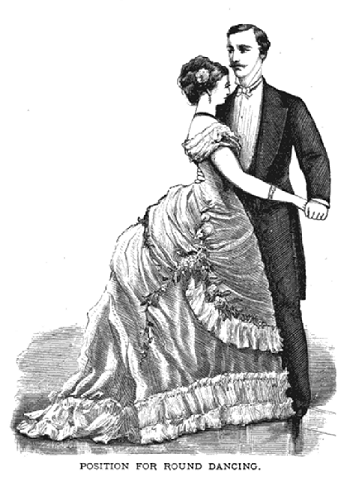
The close, body-to-body hold of the waltz and other round dances initially scandalized English society,
who quickly acclimated to its charms. In Ireland, these dances were branded from the pulpit as immoral,
and nationalist groups offered them as proof of the evils of foreign influence on pure Irish culture.
It is hardly surprising that the graceful waltz and its catchy, song-like three-beat music spread like wildfire across Europe, through England and Ireland, and to all of Europe's colonies, especially with young people. It spread first through upper class ballrooms, then rapidly migrated to the dances of working class and rural communities. It was the first of what are known today variously as 'couple dances' or 'round dances;' these were later joined by galops, polkas, schottisches, mazurkas, varsovianas and the like. 'Couple' refers to that fact that one man and one woman dance together for the entire dance, like one person on four legs ... which only added to the scandal, as earlier country dances did not allow such close, lengthy contact between individuals.
'Round' dance refers to dances where the couple, and other couples, trace a circular pattern as they slowly make their way around the periphery of the dance floor, a bit like a skate around a skating rink. Unlike plain waltzes at modern popular venues, where the dancing is more or less free-form, each individual sequence-type old-time ballroom waltz (such as the Veleta Waltz, Pride of Erin Waltz, and Parma Waltz) had its own pattern of steps that each couple performed in synch with other couples, while all slowly traveled around the dance floor. There were similar sequence dances in the other time signatures like progressive barn dance and Schottische tunes.
The waltz was easily the most popular of the round dances both with dancers and musicians, and every concertina player had a stock of them, ready for use. Here are three examples:
Ernie 'Son' James (1891-1981) was one of a number of fine concertina players to come from the Mudgee area of New South Wales, Australia. Here he plays his Cornflower Waltz, a tune which, according to folk music collector John Meredith, has been found nowhere else. Track courtesy the National Library of Australia.
Willie Palm, born in 1894 in Ficksburg in the Transvaal (now Gauteng), South Africa, was leader of the band Die Vier Huguenote in the 1930s, when this waltz recording, Vergieet nie (Never forget) was made. The track is courtesy of Die Tradisionele Boeremusiekklub van S.A.
Mary Ann Carolan (1902-1985) of The Hill of Rath, County Louth, Ireland, plays the Veleta Waltz, which was written in 1899 in England and introduced as a dance in 1900. It remains popular in Australia and amongst ballroom dance aficionados around the globe.
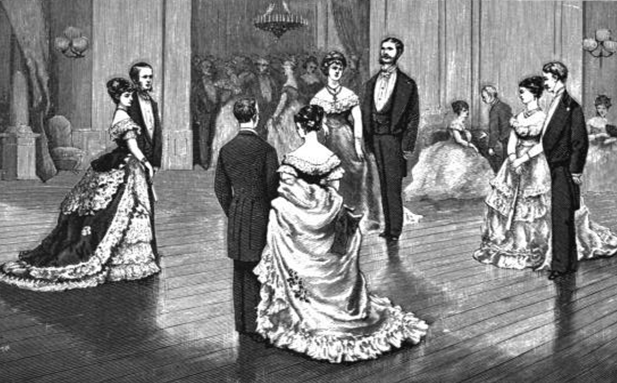
The opening position of the quadrille, with four couples forming a square.
From William De Garmo, The Dance of Society, 1875, New York.
Like the waltz, the quadrille is a partnered dance, but in this case four couples face each other in a square for a series of four to six figures that together form a set. For that reason it is sometimes known as a square dance, to separate it from contemporary round dances. Indeed, the modern American square dance is a descendant, as is the set dance (for set of quadrilles) in Ireland. The Plain Set (First Set or First Set of Quadrilles), the Lancers, and the Caledonians are early sets that were introduced in the 1820s to 1840s, and they are danced to this day in Ireland and Australia.
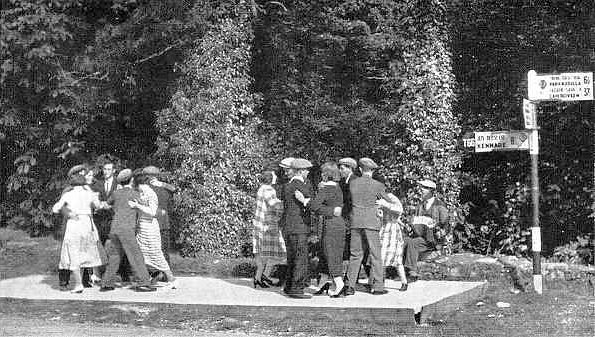
A cross-roads set dance on a wooden platform, near Kenmare, County Kerry Ireland.
From a 1948 tourist guidebook entitled 'Your Holiday in Ireland'.
What the dancers wanted was a good steady beat at a swingy march tempo, so 6/8 and 2/4 tunes predominated, although there were occasional figures in other time signatures, particularly waltz time. In the early days, higher class dances used printed scores of quadrille tunes composed for string orchestras and military bands. Themes from operettas were popular as well as arrangements of national songs from different countries. As the dance migrated deeper into society, traditional musicians in Ireland, England and Australia began to substitute popular music hall and sentimental songs, military marches, single reels and American minstrel breakdowns. In Ireland, efforts were made in the early twentieth century to 'Irish-ize' the quadrilles, to use a phrase coined by Frank Roche in his 1928 collection of traditional Irish music, which contained a section of quadrille music.![]() 22 'Irish-ization' included the substitution of Irish double reels, jigs and hornpipes for the earlier quadrille tunes, and was accompanied by a general quickening of tempo.
22 'Irish-ization' included the substitution of Irish double reels, jigs and hornpipes for the earlier quadrille tunes, and was accompanied by a general quickening of tempo.
Here are two quadrille tunes in jig tempo by Mary Ann Carolan (1902-1985): The Perfect Cure and The Morning Glory. Mrs Carolan played these tunes for quadrilles in her youth in County Louth. The recording is courtesy of RTÉ, Ireland's Public Service Broadcaster.
Dooley Chapman (1892-1982) of Coborrah, New South Wales Australia played the following Lancers tune for a figure of the Lancers quadrille. The recording is courtesy of Chris Sullivan.
George Bennett (1878-1966) of Gunnedah, New South Wales plays another Lancers Quadrille tune, in single jig tempo. The recording is courtesy of Rob Willis and the National Library of Australia.
It is likely that it made its way to England and Ireland by the 1830s, although there is little documentation, and very few mazurkas are left in the traditional repertoires of either country. In Ireland, a very few have survived the early twentieth century purge of round dances, notably in Donegal, but none are known to have been recorded by early concertina players there.
Like the waltz, the mazurka is in triple meter (3/4) time, but with a bouncy rhythm created by the addition of dotted quavers (i.e. a dotted quaver followed by a-semi quaver), which typically provides a lively nuance. The mazurka usually carries an accent on the second or third beat rather than the first beat, as in the waltz. Perhaps the most commonly known song with mazurka rhythm is Clementine, which exhibits these characteristics. The mazurka uses the same clutch-hold as the waltz, and as in the waltz a couple follows a circular pattern around the perimeter of the dance floor.
In Australia, the polka mazurka was a very popular colonial dance. The mazurka was typically a complicated dance of the dance-master's construction, whereas the polka mazurka was a simple sequenced routine that took on widely. According to Australian colonial dance authority Peter Ellis, the polka mazurka is a compound dance consisting of mazurka advances and polka step turns, but performed to mazurka music (it has no musical connection to the polka apart from perhaps an anacrusis combined with the dotted quaver that gives it spring). In the following track, Charlie Ordish (d.1966) of Corryong in northwestern Victoria, Australia plays an untitled mazurka for a polka mazurka dance. Track courtesy the National Library of Australia.![]() 23 In the following track, Charlie Ordish d.1966) of the Nariel Valley area of Victoria, Australia plays an untitled mazurka for a polka mazurka dance. The track is courtesy the National Library of Australia.
23 In the following track, Charlie Ordish d.1966) of the Nariel Valley area of Victoria, Australia plays an untitled mazurka for a polka mazurka dance. The track is courtesy the National Library of Australia.
In South Africa, the mazurka arrived at least by 1848 and became a favorite dance, with its popularity extending to the present day. Many groups have recorded mazurkas; here are two from the classic era. In the first, Stephen Emil (Faan) Harris (1886-1950) and Die Vier Transvalers play the Kroomdrai Mazurka. Harris, one of the great concertina players of his era, lived near Krugersdorp, near Johannesburg South Africa. This version is from a recording of the 1930s, courtesy of Die Tradisionele Boeremusiekklub van S.A.
Kerrie Bornman (1891-1968) was born near Vereeniging, perhaps twenty miles south of Johannesburg South Africa. Here he plays the Pietersburg Mazurka.
The characteristic dance rhythm of the polka includes a rise on the anacrusis leading into the bar with three short steps followed by a hop, as in a-one-two-three-hop, a-one-two-three-hop. Example popular songs with classic polka dance rhythm are Little Brown Jug and Polly Wolly Doodle. In dancing the polka, the man rises on the 'a-' and the couple take three short steps followed by a spring-like hop. Classically, in Australia and South Africa, the spring lies in the ball of the foot and the ankle, although in America it is often danced with great bounding strides as exampled in the film The King and I.![]() 25 The three-hop rhythm is important to the dance, as originally devised.
25 The three-hop rhythm is important to the dance, as originally devised.
Charlie Ordish (1886-1966) of Corryong, Victoria, Australia, plays a polka with a clear three-hop rhythm, So Early in the Morning, on a German concertina.
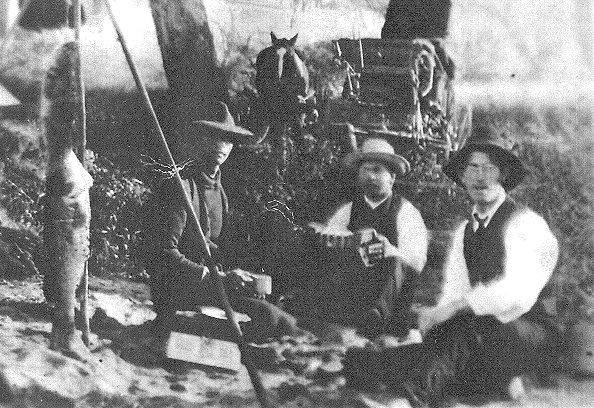
Charlie Ordish (left, with mug) and two friends, one with concertina, at camp c.1915,
probably on the Upper Murray River. With thanks to Peter Ellis.
Chris Chomse (1891-1978) of Lydenburg, about 150 miles northeast of Johannesburg, South Africa, and his band, Die Lydenburg Vastrappers, play the Bosveld polka, which has a distinctive three hop rhythm, in a recording of the 1930s. The recording is courtesy of Die Tradisionele Boeremusiekklub van S.A.
In the following recording, Willie Palm (b. 1894) of Ficksburg, South Africa and Die Vier Hugenote play the Mampoer Polka, recorded in the 1930s. The recording is courtesy of Die Tradisionele Boeremusiekklub van S.A.
Oxfordshire, England's William Kimber played a number of polkas; the following one, Little Polly, was a favorite of his. The recording, made in 1951, is courtesy of Topic Records.
The Heel and Toe Polka was a very popular round dance in late Victorian England, and there are numerous period references to it in working class haunts. Scan Tester recorded the tune several times. The Heel and Toe Polka was also popular in Australia where, in one variant, according to Ellis, a couple in a waltz hold use a heel and toe step followed by a circular polka half turn.![]() 26 Other varieties of polka collected in Australia include the Berlin Polka (an early form, also collected in Donegal, Ireland
26 Other varieties of polka collected in Australia include the Berlin Polka (an early form, also collected in Donegal, Ireland![]() 27), the Princess Polka, the Nariel Three Hop Polka, and the Kreuz Polka. Each has its own variation on the footwork and movements; all have classic three-hop rhythm. Here Ernie James (1891-1981) of New South Wales, Australia plays the Berlin Polka. The recording is courtesy the National Library of Australia.
27), the Princess Polka, the Nariel Three Hop Polka, and the Kreuz Polka. Each has its own variation on the footwork and movements; all have classic three-hop rhythm. Here Ernie James (1891-1981) of New South Wales, Australia plays the Berlin Polka. The recording is courtesy the National Library of Australia.
The polka arrived in Ireland, at least in Kerry, during the same year of 1844 that the polka arrived in England, as described in the following charming period account. A visitor to the Kerry seacoast wrote in her journal:
There are typical three hop polkas in the Roche Collection of Traditional Irish Music of 1929, in a section of dances of non-Irish origin, indicating that the ordinary polka was well known.
Elsewhere in Ireland, with the suppression of round dances in the early twentieth century (see Chapter 6), the polka was doomed to disappear, much like the mazurka, barn dance and schottische. However, set dancers began to incorporate polka tunes into their sets, as part of an effort to 'Irish-ize' the quadrille with local tunes and dance rhythms. Surviving polka sets were collected in southwestern Kerry and Cork, as well as a single locality in southwestern Limerick,![]() 30 all remote areas. The shuffling steps of the quadrilles, however, were distinctly different than those of the polka, and typically used 'marchy' tunes like single reels and single jigs, at a significantly more rapid tempo. As a result the Irish polkas underwent a rhythmic transformation, largely losing their three-hop DNA in favor of a more ONE-two-one-two rhythm, with a first note slightly lengthened and the leading anacrusis of the three-hop polka deleted; this was a better fit with the shuffle steps and battering of the Irish sets/quadrilles, often known as 'Kerry polkas'.
30 all remote areas. The shuffling steps of the quadrilles, however, were distinctly different than those of the polka, and typically used 'marchy' tunes like single reels and single jigs, at a significantly more rapid tempo. As a result the Irish polkas underwent a rhythmic transformation, largely losing their three-hop DNA in favor of a more ONE-two-one-two rhythm, with a first note slightly lengthened and the leading anacrusis of the three-hop polka deleted; this was a better fit with the shuffle steps and battering of the Irish sets/quadrilles, often known as 'Kerry polkas'.
One of many places in Munster where the polka sets were danced was Ardgroom, on the Beara Peninsula of Cork, near the Kerry border. On the following track, Ella Mae O'Dwyer (1906-1992) of Athea, West Limerick plays the Ardgroom Set, a polka set from that town. She and her husband owned a dance hall there where the sets were prominently danced. Set dancing, always of the local polka set, continued until the hall was closed in the 1950s.![]() 31 (see more on the O'Dwyers in Chapter 8). These polkas, as played by Mrs O'Dwyer for the sets, display a prominent ONE-two-one-two rhythm that is unlike the three-hop rhythm found in polkas as round dances, and is more like a single reel in feel. The recording is courtesy of Neil Wayne and Free Reed Records, who recorded Mrs O'Dwyer in 1974:
31 (see more on the O'Dwyers in Chapter 8). These polkas, as played by Mrs O'Dwyer for the sets, display a prominent ONE-two-one-two rhythm that is unlike the three-hop rhythm found in polkas as round dances, and is more like a single reel in feel. The recording is courtesy of Neil Wayne and Free Reed Records, who recorded Mrs O'Dwyer in 1974:
Bernard O'Sullivan (d. 2006) of Cooraclare, County Clare claimed that he learned most of his tunes from his mentor, the great Stack Ryan. The following polka, Stack Ryan's Polka, is played in the old octave style, and like the above tune from Mrs O'Dwyer, its rhythm has more of a single-reel rather than three-hop feel, indicating that Ryan (and O'Sullivan) likely played it for sets. The surviving sets that were collected in County Clare by Larry Lynch![]() 32 do not contain polkas. The recording is courtesy of Neil Wayne and Free Reed Records, who recorded O'Sullivan in 1974.
32 do not contain polkas. The recording is courtesy of Neil Wayne and Free Reed Records, who recorded O'Sullivan in 1974.
The assimilation of polka tunes into quadrilles clearly saved a large repertoire of Irish-composed polka tunes from oblivion. Whereas Irish music collectors largely turned up their collective noses at transcribing "foreign" schottisches, mazurkas, waltzes and the like - locally composed or not - Breandan Breathnach made a significant exception for polkas in his landmark Ceol Rince na hÉireann, and many of his polkas came from the Munster areas where the polka had been incorporated into sets. Perhaps because polkas had become so similar to single reels in Irish music, he placed the two into a single category in Volume 2, and called that section of tunes Polkas, Ríleanna Singil agus Eile (Polkas, Single Reels and Others) without attempting to classify many in that category as one or the other.

A schottische from Höselbarth's tutor of ca.1837-1840, entitled 'Anweisung das Accordion zu spielen'.
The German concertina was known in Germany as a type of accordion until about 1846.
In the schottische, the couple usually assumes a waltz position. In its simplest and earliest version, according to a Mrs Nicholas Henderson of London in her mid-1850s dance manual: 'it [has] a very elegant and withal a particularly pleasing movement, for it is a combination of two movements, a polka movement and a circular hop movement; and the two combined make up a most agreeable variety not to be found either in the Polka, the Deux Temps or Redowa.'![]() 33 Its tempo is variously 2/4 or 4/4, and is marked by a clear lengthening of the notes on the first and third beat.
33 Its tempo is variously 2/4 or 4/4, and is marked by a clear lengthening of the notes on the first and third beat.
This dance did not ignite as large a craze as had the earlier polka and waltz, but nonetheless had great staying power in many countries. Its inclusion in the repertorie of an Italian barrel organ that plied the streets of London in the early 1860s provides a good measure of its popularity. Mayhew interviewed the barrel organ's owner, who said that:
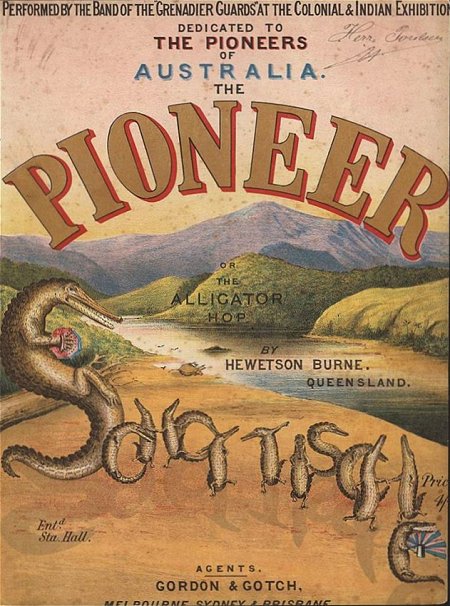
Sheet music for an Australian schottische, 1886.
Courtesy the National Library of Australia.
English schottisches played on the concertina have survived mainly through the playing of William Kimber (1872-1961) and Scan Tester (1887-1972), both of whom played for rural house and pub dances. The following recording, Kimber's Moonlight Schottische, was recorded in 1951 by Peter Kennedy and Maud Karpeles; the recording is courtesy of Topic Records.
Scan Tester knew a variety of schottisches, and the one included here was recorded in 1963. The recording is courtesy of Vic Smith and was included in Alan Day's Anglo International CD of 2005.
The schottische was danced all over Ireland. According to Helen Brennan:
In the following example, Katey Hourican (c.1890 - c.1990) of Lough Gawna, County Cavan plays The Moneymuck fling (schottische). She was recorded in the 1970s and lived to the age of 103; the recording is courtesy of Comhaltas Ceoltóirí Éireann.
Mary Ann Carolan of County Louth knew several schottisches; here is Lady Mary Ramsay. The recording is courtesy of Jim Carroll and Jim MacArdle. This tune was originally a Scottish strathspey written by Nathaniel Gow and was published by Scott Skinner.
The schottische was particularly popular in colonial Australia, and there are a great number of recordings of music for this dance, both as a standard schottische as well as a Highland schottische. Here are three; each track is courtesy of the National Library of Australia.
Con Klippel (1909-1975) plays a schottische, Grandmother Klippel's, associated with his grandmother. It is still played and danced to by his descendants in the Nariel Valley of Victoria. The recording is courtesy of his son, Keith Klippel.
George Bennett (1878-1966) plays an old schottische called Black Clouds. The recording is courtesy of the National Library of Australia.
Clem O'Neal (1912-1980), from the old mining town of Iron Bark (now Stuart Town) New South Wales Australia, plays the North Wind schottische. The recording is courtesy of Bob Bolton and the Bush Music Club of Sydney.
In South Africa, the schottische was equally popular, and is known as the settees. It was present in the Cape Colony at least by 1849, when a Miss Woolf, "Professor of Dancing," taught it and a number of other round dances, including the waltz, polka, and Redowa at her studio in Cape Town.![]() 36 Here are three schottisches, all from old 78rpm recordings of the 1930s. The rhythm in each is quite similar to the above European and Australian examples.
36 Here are three schottisches, all from old 78rpm recordings of the 1930s. The rhythm in each is quite similar to the above European and Australian examples.
Kerrie Bornman (1891-1968) came from De Deur, south of Johannesburg. Here he plays a two-row boereskonsertina in a 1930s recording of schottische called Oom Tien (Uncle Ten). The recording is courtesy of Die Tradisionele Boeremusiekklub van S.A..
Hans Bodenstein (1897-1978) of Benoni, a suburb of Johannesburg, and Die Vier Vastrappers play an Untitled settees. The recording is courtesy of Die Tradisionele Boeremusiekklub van S.A.:
Silver de Lange (1904-1956) of Vrededorp, another Johannesburg suburb, and Die Vyf Dagbrekers play the Mielieblare settees (Maize Leaves Schottische).
Englishman William Kimber (1872-1961) plays a barn dance titled Kitty Come (the recording is courtesy of Topic Records).
In Ireland, the Stack of Barley was a popular type of barn dance. This version is from the playing of Ella Mae O'Dwyer (1906-1992), courtesy of Neil Wayne and Free Reed Records.
Hans Bodenstein (1897-1978) and Die Vier Vastrappers play a Barndans met twee konsertinas (Barn Dance with Two Concertinas). The recording is courtesy of Die Tradisionele Boeremusiekklub van S.A.
In modern Australia, the galop is danced as a modified two-step.![]() 37 Here, Con Klippel (1909-1975) of Nariel, Victoria plays the Manchester Galop. In this dance the galop steps and waltz turns are used, but to a tune with more of a schottische tempo. The recording is courtesy of Keith Klippel.
37 Here, Con Klippel (1909-1975) of Nariel, Victoria plays the Manchester Galop. In this dance the galop steps and waltz turns are used, but to a tune with more of a schottische tempo. The recording is courtesy of Keith Klippel.
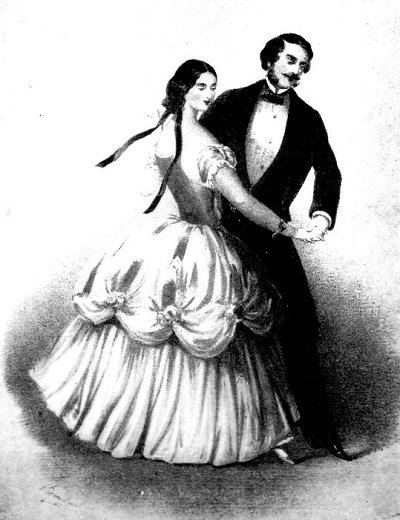
The Galup. From a middle nineteenth century music cover.
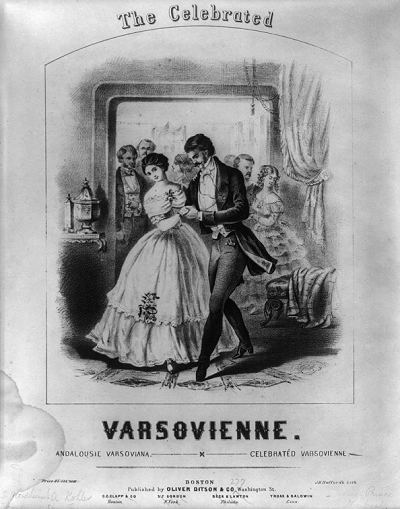
Mid-nineteenth century sheet music for 'The Celebrated Varsovienne'.
Varsovienne is the French form of the word Varsoviana.
The quintessential varsoviana tune is globally known by traditional musicians to this day. In America its tune is known as Put Your Little Foot, in Ireland as Shoe the Donkey or Father Halpin's Top Coat; in Australia it is irreverently called Kick Your Leg Up, Sal Brown or, more politely, Poor Babes in the Wood. Clem O'Neal (1912-1980) of New South Wales, Australia, plays this global tune in the old octave style in the following recording, which is courtesy of Bob Bolton and the Bush Music Club of Sydney.
Australia is rich in varsoviana tunes, and the dance seems to have remained popular much longer in the bush dance music tradition. The following varsoviana from George Bennett (1878-1966) shows similarities to the arch-typical original version. The recording is courtesy of the National Library of Australia.
Here is another example, the Turn Around and Then Stop varsoviana, from Charlie Ordish (d.1966) of Victoria. The recording is courtesy of the National Library of Australia.
Many popular songs were used as march tunes, such as the Minstrel Boy in Ireland, or Golden Slippers almost anywhere. In British colonial settings, such as in Australia, a string of national airs from various parts of the Empire might be used (for example, Rule Britannia, Scotland the Brave, Men of Harlech, etc).
Ella Mae O'Dwyer (1906-1992) of Athea, West Limerick, Ireland, plays an Untitled March. In Chapter 11, there is a recording of another of her marches, played by her son Sean O'Dwyer.
Mary Ann Carolan (1902-1985) of The Hill of Rath, County Louth, Ireland, plays Napoleon's March.
Fred Kilroy (ca.1910 - ca.1976) of Royton, Lancashire, England, plays Blaze Away, an American march tune written in 1901 that was popular both in England and in Australia, where it was used as a promenade tune. In Kilroy's Lancashire as well as in northern Ireland there is a long-standing tradition of concertina bands that play march tunes in street processions.
13. Breandan Breathnach, Tús an Poirt in Éireann (The origin of the jig in Ireland), Irish Folk Music Studies, vol. 1 (1972-1973).
14. Helen Brennan, 1999, The Story of Irish Dance: Brandon, Dingle, County Kerry, Ireland, pp.22-23.
15. Breandan Breathnach, 1971, Folk Music and Dances of Ireland: Mercier Press, Dublin, p.47.
16. Scan Tester, as quoted in Reg Hall, 1990, I Never Played to Many Posh Dances: Musical Traditions supplement No. 2, p.77.
17. Peter Ellis, 2005, The Merrie Country Dance: Bendigo Dance and Music Club, Victoria Australia.
18. Peter Ellis, 2005, The Merrie Country Dance: Bendigo Dance and Music Club, Victoria Australia; and 2007, The Waltz, the Polka, and All Kinds of Dance Music, same publisher.
19. Peter Ellis, 2005, The Merrie Country Dance: Bendigo Dance and Music Club, Victoria Australia, p.B103, and Helen Brennan, 1999, The Story of Irish Dance: Brandon Press, Dingle Ireland, p.99.
20. Wilhelm Schultz, 2001, Die Ontstaan en Ontwikkeling van Boeremusiek (The Origin and Evolution of Boer music): A.V.A. Systems, Pretoria, p.107.
21. Elizabeth Grant and Andrew Todd, 1992, Memoirs of a Highland Lady:Canongate, U.S., p.47.
22. Frank Roche, 1929, The Roche Collection of Traditional Irish Music, republished in 1982 by Ossian Publications, Cork.
23. Peter Ellis, 2005, p.E35.
24. eg., see Wikipedia entry, Polka.
25. Peter Ellis, 2005, p.E34.
26. Peter Ellis, 2005, p.E23.
27. Grace Orphen, 1931, Dances of Donegal: London, D.M. Wilkie, pp.31.
28. Catherine O'Connell, Excursions in Ireland During 1844 and 1850, With a Visit to the Late Daniel O'Connell, M.P.(London: Richard Bentley Co., 1852) pp.47-48.
29. Helen Brennan, 1999, The Story of Irish Dance: Brandon, Dingle, County Kerry, Ireland, p.101.
30. Larry Lynch, 1991, Set Dances of Ireland, Traditions & Evolution: Séadna Books, San Francisco p.147.
31. Ibid., p.147.
32. Larry Lynch, 1989, Set Dances of Ireland: Tradition and Evolution: Séadna Books, San Francisco, p.324.
33. Henderson, Mrs Nicholas, Etiquette of the Ball-Room and Guide to all the New and Fashionable Dances. 3rd ed., London, n.d. (c.1854). Also, Henderson, Mrs Nicholas, 'Instructions for Dancing the Schottisch' on sheet music 'The Hungarian Schottische'. London, n.d. (mid-1850s?). With thanks to www.kickery.com
34. Henry Mayhew, 1861, London labour and the London poor: London, Griffin, Bohn and Co., p.178.
35. Helen Brennan, 1999, p.100.
36. Wilhelm Schultz, 2001, p.28.
37. Peter Ellis, 2005, p.E18.
| NEXT |